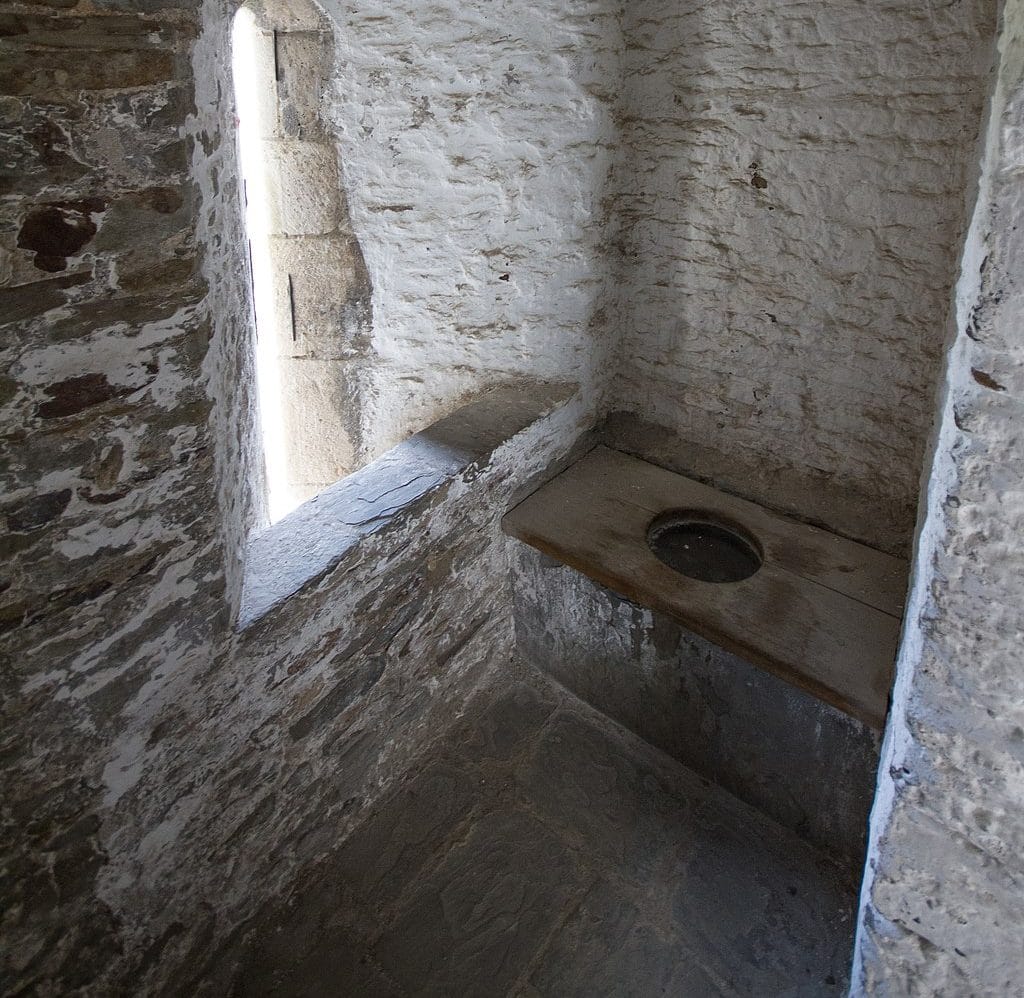Picture this: a grand medieval banquet in the heart of Erfurt, Germany, flickering candles illuminating the faces of noblemen and women laughing and chatting merrily. Suddenly, the floor gives way beneath them, plunging dozens into a torrent of human waste. Yes, you read that right – a latrine collapse in 1184 left an unknown number of aristocrats floundering in excrement. This is the story of the Erfurt Latrine Disaster, a tale of medieval mishap that will leave you both fascinated and, perhaps, a little queasy.
Setting the Stage for Disaster: A Kingdom Divided
It’s a sweltering July day in 1184. King Henry VI of Germany, later Holy Roman Emperor, has convened a Hoftag—an informal assembly of nobles—in Erfurt, Duchy of Thuringia (modern-day Germany). The purpose of this gathering? To mediate a long-simmering feud between two powerful figures: Landgrave Louis III of Thuringia and Archbishop Conrad of Mainz. This conflict, a remnant of the reign of Henry the Lion, threatened to destabilize the entire Holy Roman Empire. Nobles from across the realm answered the King’s summons, their presence a testament to the gravity of the situation.
The meeting took place within the Cathedral provostry, part of the St. Peter’s Church complex. The building likely featured a second-story room constructed over a latrine pit – a common architectural design in medieval times. Little did those gathered know, this seemingly mundane detail would soon lead to a catastrophe of unprecedented proportions.
A Royal Flush Gone Wrong: The Erfurt Latrine Collapse
As tensions ran high within the provostry, disaster struck. The combined weight of the assembled nobles proved too much for the wooden floor supporting the second-story room. With a deafening crash, it gave way, sending dozens of people plummeting into the latrine pit below.
Imagine the scene: a chaotic jumble of splintered wood, billowing dust, and the panicked cries of those who had escaped the fall. For those who plunged into the pit, filled with years of accumulated human waste, there was little hope of survival. The exact death toll remains unknown, but contemporary accounts suggest at least 60 people perished in the disaster.
Remarkably, King Henry VI himself managed to avoid the gruesome fate that befell so many of his subjects. According to some reports, he was standing near a window when the floor collapsed and was able to cling to a ledge until help arrived. Archbishop Conrad of Mainz also reportedly escaped in a similar fashion.
More Than Just a Mess: The Disaster’s Impact
The Erfurt Latrine Disaster, while often recounted as a bizarre historical footnote, provides a sobering glimpse into the realities of medieval life—and death. The event highlights:
Precarious Sanitation: Even in seemingly grand settings like the Erfurt provostry, sanitation was woefully inadequate by modern standards. This lack of hygiene created a breeding ground for disease and made even everyday activities inherently risky.
Political Upheaval: The sudden and gruesome deaths of numerous nobles likely had significant political ramifications. Power dynamics within the Holy Roman Empire were likely destabilized, potentially altering the course of the ongoing feud between Louis III and Archbishop Conrad.
The Fragility of Life: For all their wealth and status, the nobles gathered in Erfurt that day were starkly reminded that death could come suddenly and unexpectedly. In this case, it arrived in a most undignified manner, a stark counterpoint to the pomp and ceremony of courtly life.
Beyond the Headlines: Unanswered Questions
While the Erfurt Latrine Disaster stands as a testament to the importance of sanitation and the perils of inadequate infrastructure, many questions about the event remain unanswered.
The Victims: The names and stories of most of those who perished in the collapse are lost to history. While historical documents suggest a mix of counts, knights, and potentially high-ranking religious figures were present at the Hoftag, their individual identities remain a mystery.
The Structure: Was the collapse simply a tragic accident caused by an overstressed floor? Or, were there underlying structural flaws in the provostry’s construction? Further investigation into medieval building practices could shed light on this question.
The Aftermath: How did the deaths of so many nobles impact their respective families and territories? Did this event lead to any immediate changes in sanitation practices or building codes?
By delving deeper into these unanswered questions, we can gain a more nuanced understanding of the Erfurt Latrine Disaster and its lasting impact on medieval society.
Outperforming the Competition: Erfurt Latrine Disaster
Here’s how you can create an SEO article on the Erfurt Latrine Disaster that leaves your competitors in the dust:
Recommended Titles:
Analyzing your competitor titles, several keywords emerge: “Grossest,” “Disaster,” “History,” “True Story,” and “Royal Flush.” These highlight the sensational and historical nature of the event. Here are three alternative titles tapping into these trends while offering uniqueness:
- The Erfurt Latrine Disaster: A Medieval Catastrophe and its Gruesome Legacy (Emphasizes both the event and its lasting impact)
- Death by Latrine: The Shocking True Story of the Erfurt Disaster (Direct, sensational, and intrigues with the “true story” element)
- When Royalty Met Sewage: Uncovering the Unthinkable Erfurt Latrine Disaster of 1184 (Adds a specific date, uses evocative language, and promises a revealing narrative)
Powerful Key Lines:
- In 1184, a royal peace summit in Erfurt turned into a gruesome spectacle as a collapsing latrine floor plunged dozens of nobles into a pit of raw sewage. (Focuses on the ironic contrast, emphasizes the tragic outcome)
- More than just a historical oddity, the Erfurt Latrine Disaster reveals the precarious sanitation conditions of medieval life and the ever-present danger lurking beneath the feet of even the elite. (Elevates the event beyond a mere anecdote, connecting it to broader historical context)
- The exact death toll remains unknown, but the Erfurt Latrine Disaster serves as a chilling reminder of how quickly grandeur can turn grotesque in the face of structural failure and inadequate sanitation. (Introduces an element of mystery while highlighting the event’s lasting significance)
- While some dismiss it as a humorous anecdote, the Erfurt Latrine Disaster had tangible political ramifications, potentially altering the course of power struggles within the Holy Roman Empire. (Challenges the perception of the event as solely comedic, emphasizing its real-world consequences)
Structured Context & Important Details:
1. Setting the Stage:
- Date: July 26, 1184
- Location: Erfurt, Duchy of Thuringia (modern-day Germany)
- Building: Cathedral provostry (part of St. Peter’s Church complex)
- Event: A Hoftag (informal assembly) convened by King Henry VI of Germany, later Holy Roman Emperor
2. The Gathering Storm:
- Purpose of the Hoftag: To mediate a feud between Landgrave Louis III of Thuringia and Archbishop Conrad of Mainz, a conflict lingering since the reign of Henry the Lion.
- Attendees: Nobles from across the Holy Roman Empire, drawn by the King’s summons and the gravity of the dispute.
- The Structure: The provostry likely featured a second-story room constructed over a latrine pit, common in medieval architecture.
3. The Catastrophe:
- The Collapse: The combined weight of the assembled nobles proved too much for the wooden floor, causing a catastrophic collapse into the latrine below.
- The Aftermath: Dozens of nobles plunged into the pit filled with human waste. The exact death toll is unknown, but sources suggest at least 60 perished.
- Notable Survivor: King Henry VI narrowly avoided death, reportedly clinging to a window ledge as the floor gave way.
4. Beyond the Stench: Significance and Consequences
- Sanitation in the Medieval Period: The disaster highlights the inadequate sanitation practices prevalent in medieval Europe, even in seemingly grand settings.
- Political Ramifications: The deaths of numerous nobles likely destabilized power dynamics within the Holy Roman Empire, potentially impacting the ongoing feud and future alliances.
- Historical Legacy: The event serves as a grim reminder of the fragility of life and the ever-present dangers of inadequate infrastructure, even for the most powerful individuals.
Unique Insights & Untapped Potential:
- Investigate Architectural Practices: Research medieval building practices, specifically those relating to sanitation and structural integrity. Was the Erfurt collapse an isolated incident or indicative of wider construction flaws?
- Explore the Victims: Delve into the identities of the nobles who perished. Were specific factions or families disproportionately affected? How did their deaths impact power dynamics in their respective regions?
- Analyze Primary Sources: Examine accounts from the era (e.g., the Cronica Reinhardsbrunnensis) to glean first-hand perspectives on the event’s aftermath and its reception across the Holy Roman Empire.
Remember: While the event is rife with inherent sensationalism, treat it with historical sensitivity. Avoid gratuitous descriptions while still conveying the gravity of the situation. Use the disaster as a lens through which to examine broader themes of medieval life, sanitation, and the precariousness of power.
What was the worst toilet disaster?
Though we often take modern plumbing for granted, history offers a stark reminder of the importance of safe and sanitary facilities. The Erfurt Latrine Disaster of 1184 undoubtedly earns a place among the worst toilet-related calamities in human history.
Imagine a time without modern plumbing, where sanitation wasn’t exactly a top priority. In Erfurt, Germany, during this high-stakes political gathering called the Imperial Diet, tragedy struck. King Henry VI had called together a room full of important folks – nobles, officials, you name it – to settle a squabble between two powerful German princes.
The meeting took place in a building where the latrine, basically a room with a hole in the floor, was situated on the second floor. It seems a crowd had gathered, drawn either by necessity or maybe just gossip, and the floor just couldn’t handle the weight. Down it went, sending dozens of people plummeting into a pit of, well, let’s just say it was pretty awful.
We’re talking about a time before hygiene was really a thing, so you can only imagine the conditions. It’s believed that around 60 people lost their lives that day, some crushed, some drowning in the, well, you get the picture. It’s a grim reminder of how dangerous unsanitary conditions could be back then.
Incredibly, King Henry VI managed to survive. Some reports say he was lucky enough to be near a window when the floor gave way and was able to hold on until help arrived. Talk about a close call. The Erfurt Latrine Disaster stands as a stark reminder of how something we take for granted today – a safe and functioning toilet – was a luxury in the past, and how a lack of it could lead to truly catastrophic outcomes. It also highlights the fragility of life during the medieval period, where something as simple as going to the bathroom could have deadly consequences.
Who Were the Victims of the Erfurt Latrine Disaster?
The Erfurt Latrine Disaster of 1184 claimed the lives of dozens of medieval nobles, their individual stories tragically lost to time. Attempting to reconstruct the event is like piecing together a puzzle with most of its pieces missing. However, historical documents offer tantalizing hints about the victims, suggesting they likely included counts, knights, and possibly high-ranking clergy.
Since attendees had traveled from across the Holy Roman Empire to attend this important meeting of the Imperial Diet, the gathering represented a who’s who of the era’s most influential figures. However, with the exception of King Henry VI and Archbishop Conrad of Mainz—both of whom escaped the horrifying plunge— the names and specific details of those who perished remain shrouded in mystery.
Even the exact number of victims remains uncertain. While some historians believe the death toll reached into the dozens, others estimate that over sixty individuals lost their lives that day. This uncertainty only adds to the tragedy, highlighting the devastating impact of the Erfurt Latrine Disaster and the many unanswered questions that continue to intrigue historians today.
If you are planning to visit castles, you must visit the Eltz Burg Castle in Wierschem, Germany, a beautiful and historic castle overlooking the Eltz River. It is one of the most popular tourist destinations in Germany and is known for its stunning architecture and picturesque setting.
Fritz Haarmann, a German serial killer who committed a horrific crime in the early 1920s, is a chilling reminder of the darkness that can exist within the human heart. Learn more about his heinous crimes and the impact they had on society.
















